When most people think about radishes, they envision a small, globe-shaped, red root with a white center and a slightly spicy flavor. However, there’s actually a lot of diversity in the radish family, and you can find radishes in almost any color. What’s more, radishes are often classified as either spring radishes, summer radishes, winter radishes, or seedpod radishes, depending on their temperature tolerance and other factors.
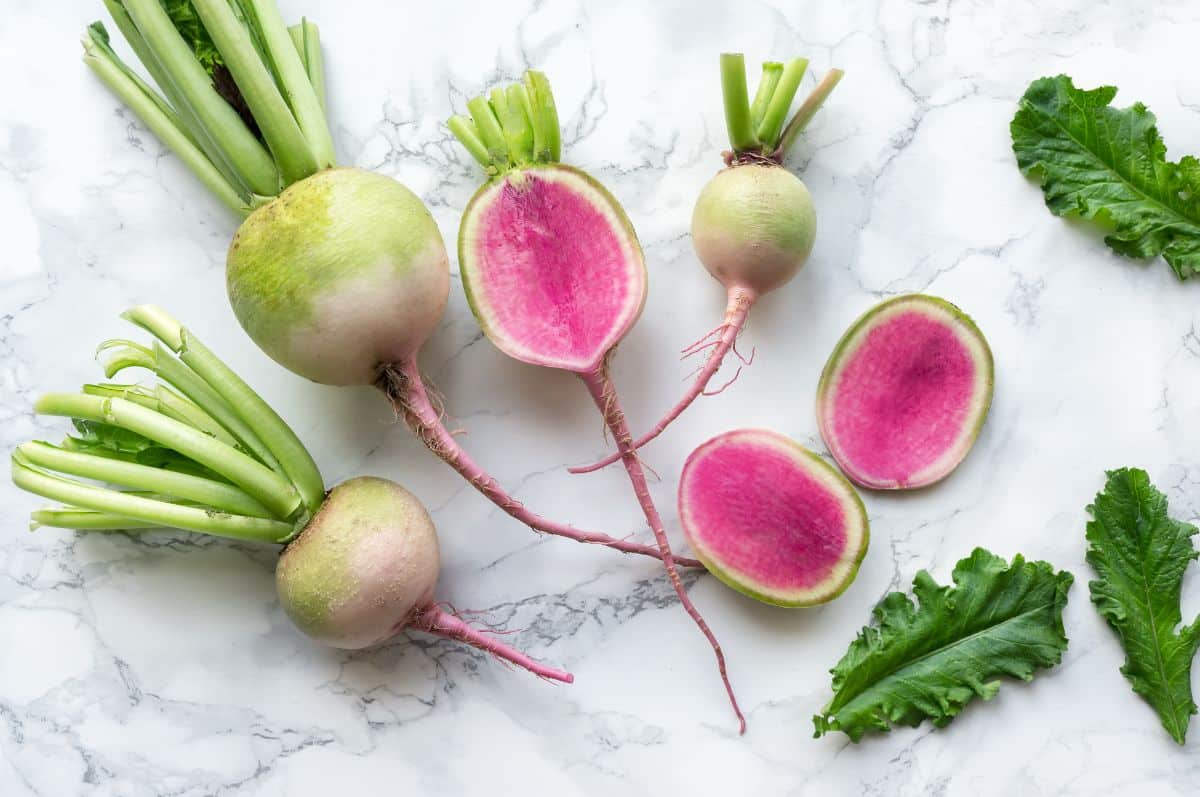
In this guide, we’ll introduce you to some of our favorite radishes to grow throughout the year. With a bit of planning, you can plant these radishes in succession and grow a continuous radish harvest from spring through fall!
Jump to:
- 20 radishes to grow from spring through fall
- 1. Easter Egg
- 2. French Breakfast
- 3. Round Black Spanish
- 4. Watermelon
- 5. Japanese Wasabi
- 6. White Icicle
- 7. Cheriette
- 8. Early Scarlet Globe
- 9. Sakurajima Giant
- 10. Heilos
- 11. Plum Purple
- 12. Zlata
- 13. Green Meat
- 14. Tokinashi
- 15. Pusa Jamuni
- 16. Red Rat’s Tail
- 17. Saitaro
- 18. Korean Fall Storage
- 19. Shunkyo
- 20. China Rose
- Summary
20 radishes to grow from spring through fall

Radishes are commonly thought of as spring vegetables, but if you choose the right radish seeds for your garden, you can grow radishes throughout the year.
1. Easter Egg
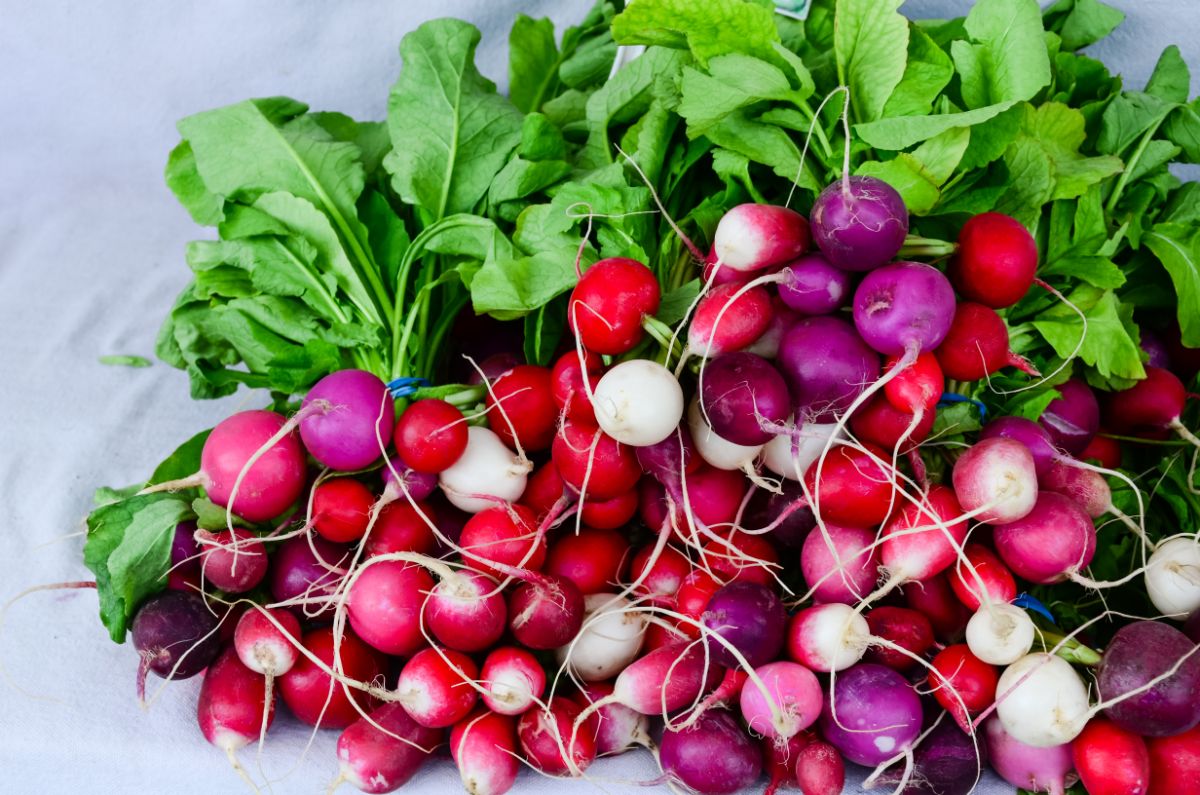
| Radish variety: | Easter Egg |
| Planting season: | Spring and fall |
| Days to maturity: | 25 days |
| Skin color: | Purple, pink, white |
| Interior color: | White |
One of the most popular and prolific radish varieties on the market today, ‘Easter Egg’ radishes are a top choice among market growers thanks to their richly colored roots. Like their namesake Easter eggs, these radishes come in brilliant shades of purple, pink, and white, and they are particularly appealing when plated or bundled together. ‘Easter Egg’ radishes are also ultra cold hardy, but they don’t often bolt in the summer heat, and they’re ready to harvest in just 25 days!
Even when grown in warmer weather, ‘Easter Egg’ radishes don’t turn hollow, and they don’t get very spicy, either. I personally always save space in my garden for these beauties, which are delicious and fresh, and they also hold their color well after roasting!
2. French Breakfast

| Radish variety: | French Breakfast |
| Planting season: | Spring and fall |
| Days to maturity: | 26 days |
| Skin color: | Red with white tip |
| Interior color: | White |
Probably the most classic radish variety around, ‘French Breakfast’ radishes have been popular since at least the late 1800s, and they were the radish of choice in Parisian markets at the time. But the popularity of ‘French Breakfast’ radishes has only spread over the years, and these radishes are highly prized at farmer’s markets for their colorful and elongated roots. ‘French Breakfast’ radishes have a brilliant red color, but their tips are a bright white for excellent contrast.
Most often, ‘French Breakfast’ radishes are cooked in butter and then served with crispy toast and a poached egg. But these versatile roots are also scrumptious roasted or served fresh. A fast grower, the ‘French Breakfast’ radish is ready to pick in about 26 days, but you’ll need to harvest them early as they often turn hollow with age.
3. Round Black Spanish

| Radish variety: | Round Black Spanish |
| Planting season: | Late summer |
| Days to maturity: | 65 days |
| Skin color: | Black |
| Interior color: | White |
‘Round Black Spanish’ radishes are even older than ‘French Breakfast’ radishes, and they have been cultivated in Kew Botanical Gardens since at least 1548. These radishes have unique jet-black skin and a bright white interior that looks very striking when sliced. However, ‘Round Black Spanish’ radishes are mostly known for their intense heat, which can be mellowed out somewhat with cooking.
A larger radish variety, ‘Round Black Spanish’ is about the size of a turnip with 4” diameter roots. These plants are slower to grow, and they take about 65 days to reach maturity, which is why they’re often planted towards the end of summer for an autumn harvest.
4. Watermelon
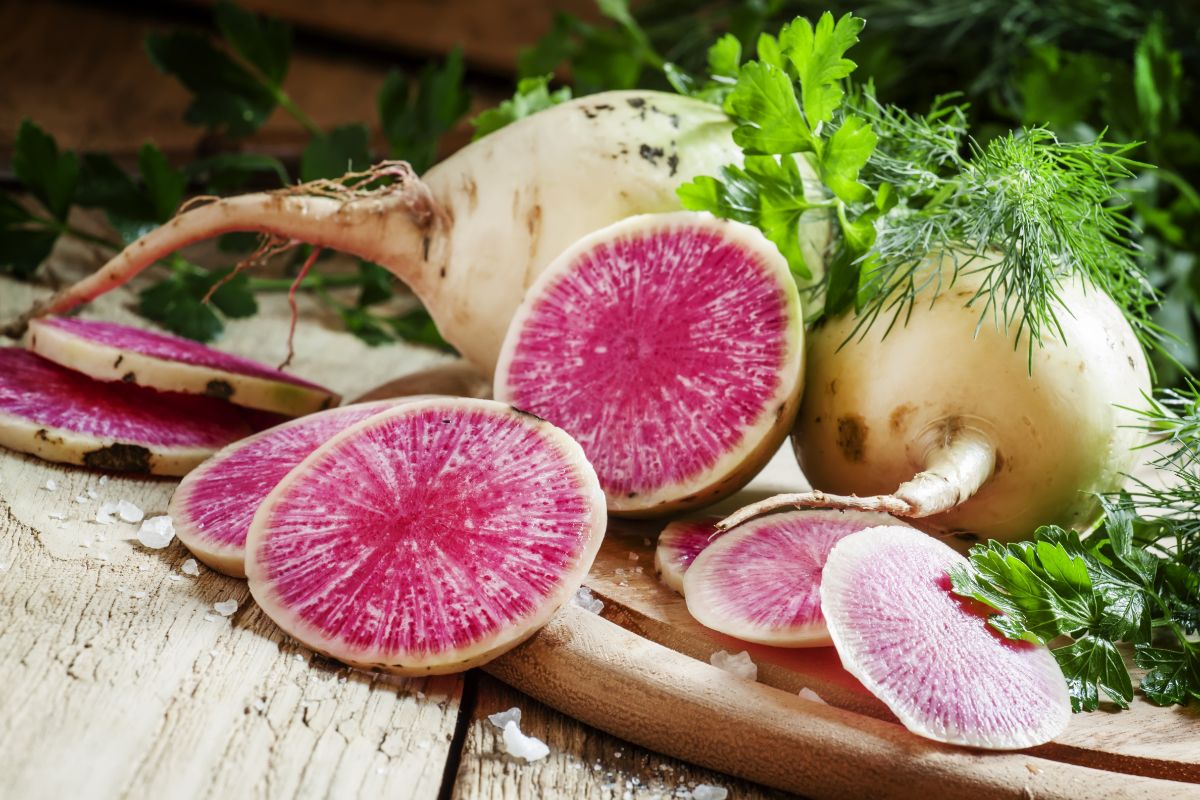
| Radish variety: | Watermelon |
| Planting season: | Late summer |
| Days to maturity: | 55 days |
| Skin color: | Pale green |
| Interior color: | Pink |
‘Watermelon’ radishes are another fall favorite, and they’re usually planted in mid-August and harvested about 55 days later. While ‘Watermelon’ radishes don’t handle heat well, they’re very cold hardy. In fact, one of the joys of growing ‘Watermelon’ radishes is these roots store beautifully in root cellars in winter!
As their name suggests, ‘Watermelon’ radishes are mostly known for their brilliantly colored flesh, which is green on the outside and a brilliant rose pink inside. But it’s not just about looks with ‘Watermelon’ radishes. These plants are also scrumptious with a perfectly balanced sweet flavor that pairs beautifully with butter and a touch of salt.
5. Japanese Wasabi

| Radish variety: | Japanese Wasabi |
| Planting season: | Spring and late summer |
| Days to maturity: | 60 days |
| Skin color: | Green and white |
| Interior color: | Green |
True wasabi is an expensive plant that’s hard to grow in standard garden conditions. Because of this, many gardeners resort to growing horseradish as a wasabi alternative. But there is another option: ‘Japanese Wasabi’ radishes!
These bright green radishes have all the heat you crave in wasabi but in an easy-to-grow radish form. Ready to harvest in about 60 days, ‘Japanese Wasabi’ radishes are usually grown in spring or autumn, and their leaves are also super tasty. Try grating these radishes over sushi, poke bowls, and your other favorite dishes for spicy heat that just won’t quit!
6. White Icicle
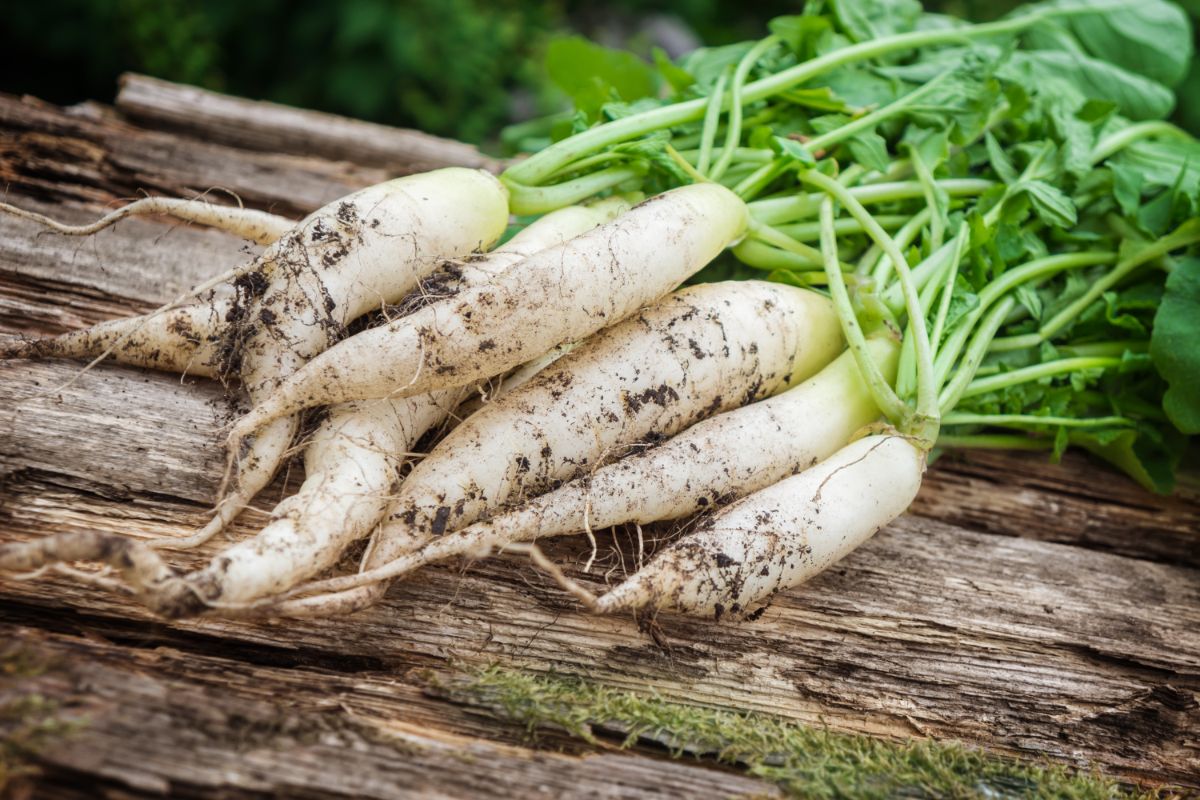
| Radish variety: | White Icicle |
| Planting season: | Spring through fall |
| Days to maturity: | 30 days |
| Skin color: | White |
| Interior color: | White |
Aptly named ‘White Icicle’ radishes have brilliant white and tapering roots that can grow up to 6” long. These radishes look attractive when sold in bunches at farmer's markets, but their slender shape also makes them super easy to cut. Not to mention, these radishes are ready to pick in just 30 days, and they have better heat tolerance than many other radishes, allowing you to grow them into early summer.
When harvested young, ‘White Icicle’ radishes have a mild flavor, but their heat intensifies as they age. Even in poor soils, these radishes can grow prolifically, although they’ll grow even better in rich, loose earth. ‘White Icicle’ radishes are also often used as companion plants for squash because their scent repels many different pest insects.
7. Cheriette
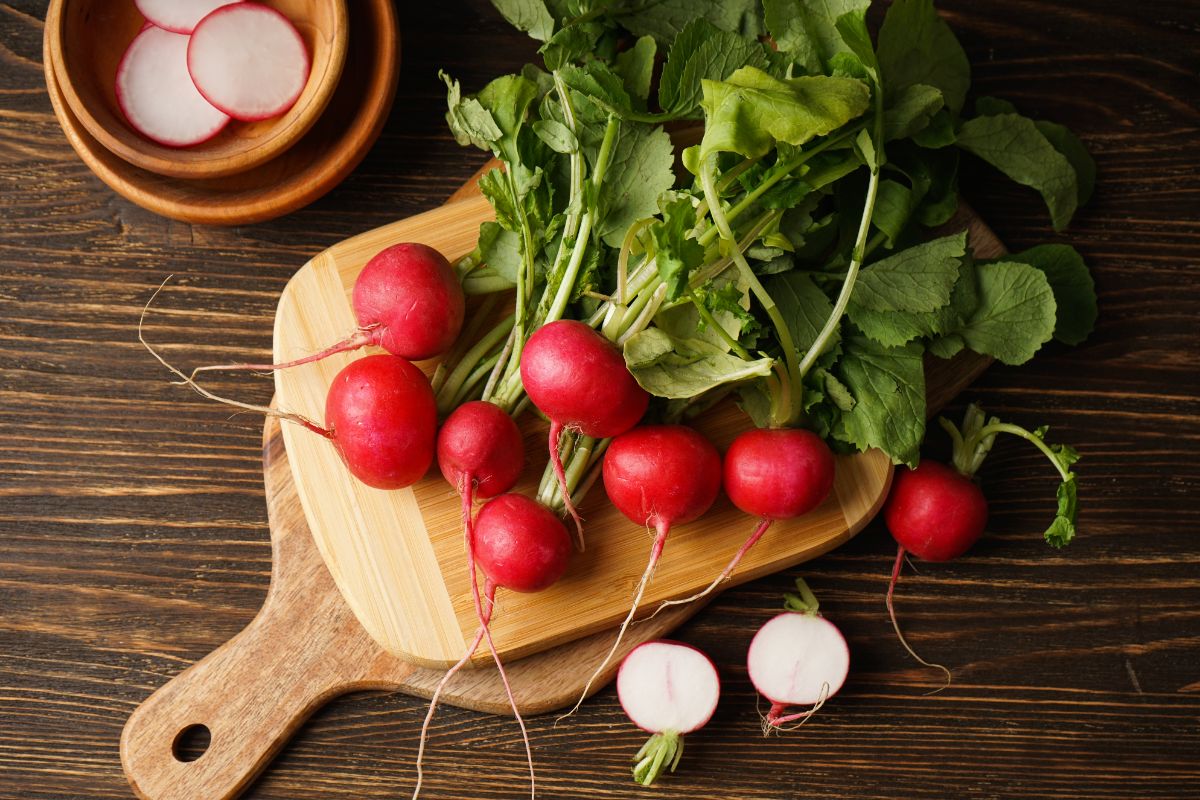
| Radish variety: | Cheriette |
| Planting season: | Spring through fall |
| Days to maturity: | 26 days |
| Skin color: | Red |
| Interior color: | White |
‘Cheriette’ radishes are a hybrid radish type, so they aren’t good for seed saving. However, these plants have been specially curated for their heat tolerance, and they can withstand warm weather much better than many other open-pollinated radish types. With bold, red skin and a neat, round form, ‘Cheriette’ looks a lot like a ripe cherry, although its center is a pure, snow-white color!
Another good choice for market gardening, ‘Cheriette’ has a complex flavor with the perfect balance of spicy tang and sweetness. These radishes also have short tops that won’t flop over, and they mature in just 26 days. Since they grow so rapidly, you may be able to get a couple of spring harvests of ‘Cherriette’ radishes and some autumn harvests too!
8. Early Scarlet Globe

| Radish variety: | Early Scarlet Globe |
| Planting season: | Spring through fall |
| Days to maturity: | 22 days |
| Skin color: | Red |
| Interior color: | White |
A classic spring radish, ‘Early Scarlet Globe’ is one of the fastest-growing radishes you can find, and it’s ready to pick in just 22 days! Sow multiple plantings of these radishes in spring, and you can get a lot of produce out of your garden even before summer starts. Plus, these radishes are simply pretty to look at, with scarlet red skin and crisp, white interior flesh.
‘Early Scarlet Globe’ radishes also have better heat tolerance than many other cultivars, so they can be planted throughout the growing season. That said, these plants will grow best in spring and autumn, and they make colorful additions to sandwiches, salads, and plenty of other recipes.
9. Sakurajima Giant
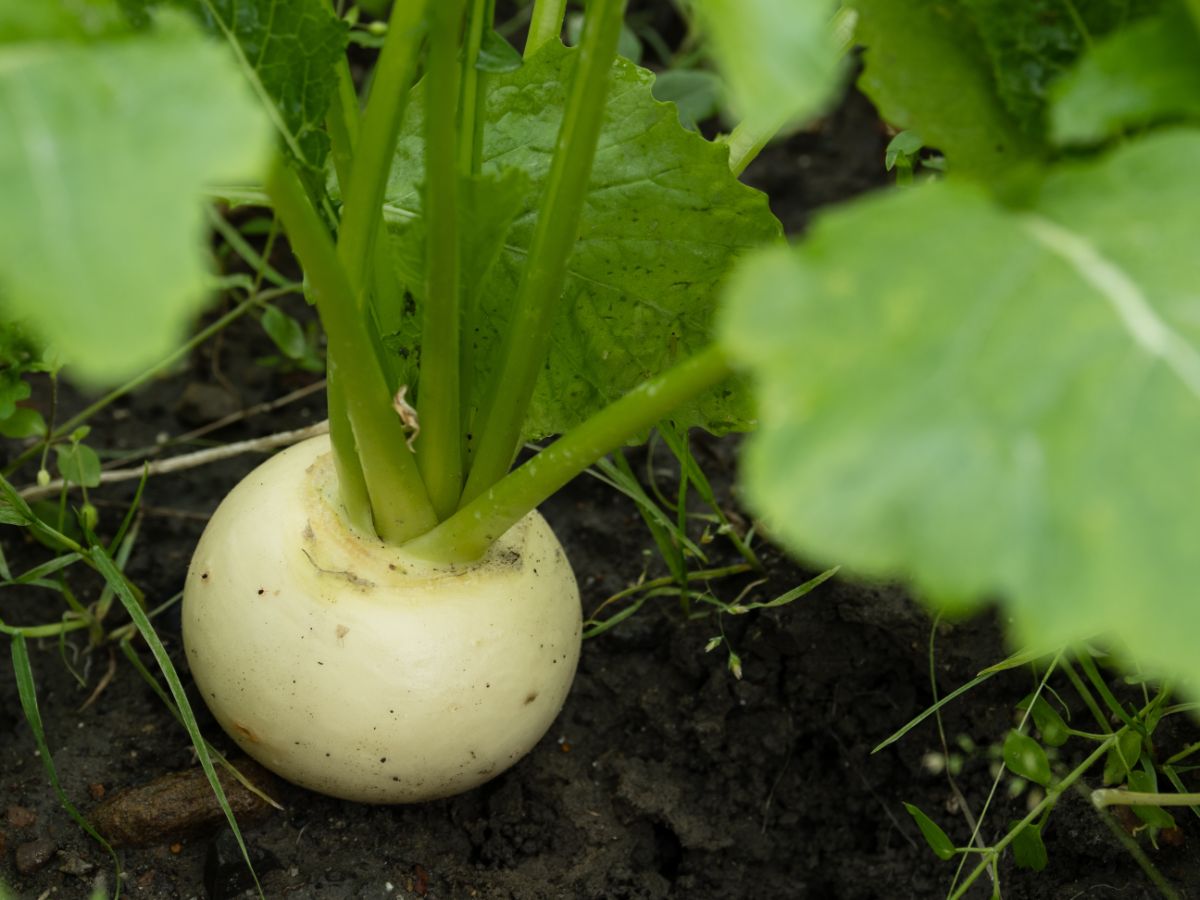
| Radish variety: | Sakurajima Giant |
| Planting season: | Late summer |
| Days to maturity: | 90 days |
| Skin color: | White |
| Interior color: | White |
Nicknamed the “King of Daikons,” the ‘Sakurajima Giant’ radish is one of the most exciting radish varieties you can grow simply because it’s so massive. This radish has been grown in Japan since at least the 1800s, and it has a delicious flavor and crunchy texture too. Most growers keep ‘Sakurajima Giant’ for its size, and some of these radishes have weighed in at 100 pounds each!
While ‘Sakurajima Giant’ radishes are definitely hefty, they usually max out at around 15 pounds. These plants have excellent cold resistance, and they’re typically planted in autumn for a winter harvest. ‘Sakurajima Giant’ also stores well in cold cellars, but these radishes do take a while to grow, and they’re generally harvested about 90 days after planting.
10. Heilos
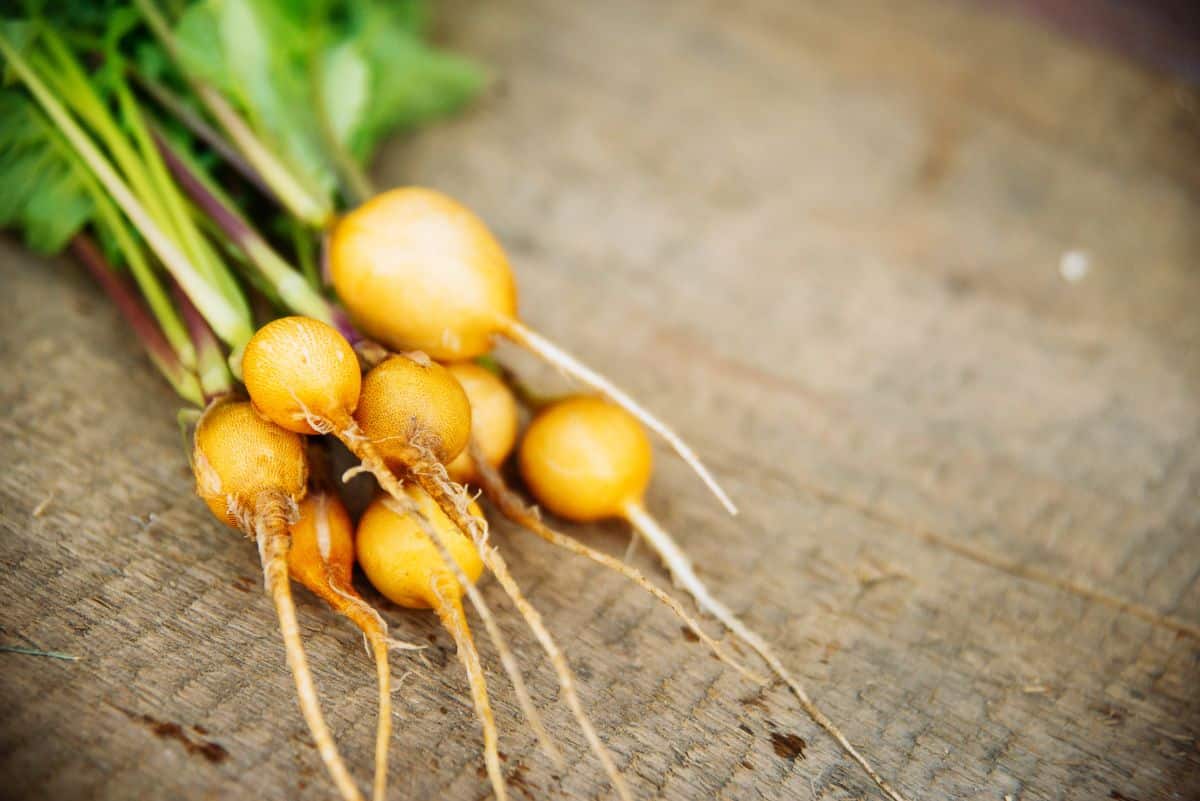
| Radish variety: | Helios |
| Planting season: | Spring and fall |
| Days to maturity: | 25 days |
| Skin color: | Golden yellow |
| Interior color: | White |
Originally from Czechoslovakia, ‘Helios’ is a striking radish cultivar with golden yellow skin that’s truly unique. A fast grower, this radish is usually grown in spring or autumn, and it’s ready to dig up in 25 days. Plus, these radishes are heirlooms, so you can save their seeds as well!
Like other radishes, ‘Helios’ radishes can grow in a range of soil types, although they will grow best in rich, well-draining earth. To give your plants a boost, you may want to amend your garden soil with compost or aged manure in spring before planting your seeds. Radishes will also grow best when they’re watered regularly with about 1” of water per week.
11. Plum Purple

| Radish variety: | Plum Purple |
| Planting season: | Spring and fall |
| Days to maturity: | 26 days |
| Skin color: | Purple |
| Interior color: | White |
‘Plum Purple’ is another colorful radish option with rich, pinkish-purple skin and a crisp, white interior. These radishes are ready to pick in 26 days, and they have a mild sweetness with only a bit of spice. Mature ‘Plum Purple’ radishes grow to about the size of ping pong balls, and they’re delicious, both fresh and roasted.
While radishes are relatively pest resistant, they can sometimes still be targeted by pests like the root maggot. To avoid this, many growers keep radishes under floating row covers, but this can cut the amount of light radishes receive during the day. Luckily, ‘Plum Purple’ radishes don’t seem to mind one bit, and they will still grow abundantly even when cultivated in light shade.
12. Zlata

| Radish variety: | Zlata |
| Planting season: | Spring through fall |
| Days to maturity: | 30 days |
| Skin color: | Golden yellow |
| Interior color: | White |
Most radishes are cool-weather crops, and it can be hard to find radish seeds that will flourish in summer gardens. But if you want to grow radishes in summer and you love the thought of keeping a more unusual radish variety, ‘Zlata’ radishes may be the radish for you. These radishes hail from Poland, and they’re noteworthy for their golden-yellow skin and heat tolerance.
‘Zlata’ is ready to harvest in 30 days, and its flesh is rather spicy but not overwhelmingly so. You can eat ‘Zlata’ fresh in a variety of dishes, but its flavor really shines after braising. Even better, in growing trials, ‘Zlata’ radishes didn’t crack in wet weather, and their tender leaves are delicious too!
13. Green Meat

| Radish variety: | Green Meat |
| Planting season: | Late summer |
| Days to maturity: | 55 days |
| Skin color: | Green and white |
| Interior color: | White |
Even vegans and vegetarians can delight in ‘Green Meat,’ which is a gorgeous, miniature daikon radish with a bright, apple-like flavor. This radish produces long and tapering roots that can stretch up to 9” long and 3” wide. Those roots are also bi-colored with white tips and sturdy shoulders that grow above the soil line and turn a deep green tone in the sun.
Like other root vegetables, ‘Green Meat’ will grow best in loose soil, so you may want to work some compost into your garden before planting your seeds. ‘Green Meat’ radishes mature in 55 days, and they have a crisp texture that’s equally appealing when used in pickled recipes or fresh dishes. Another excellent selection for autumn gardens, ‘Green Meat’ has a good deal of cold tolerance, and it can also be stored in root cellars until spring!
14. Tokinashi
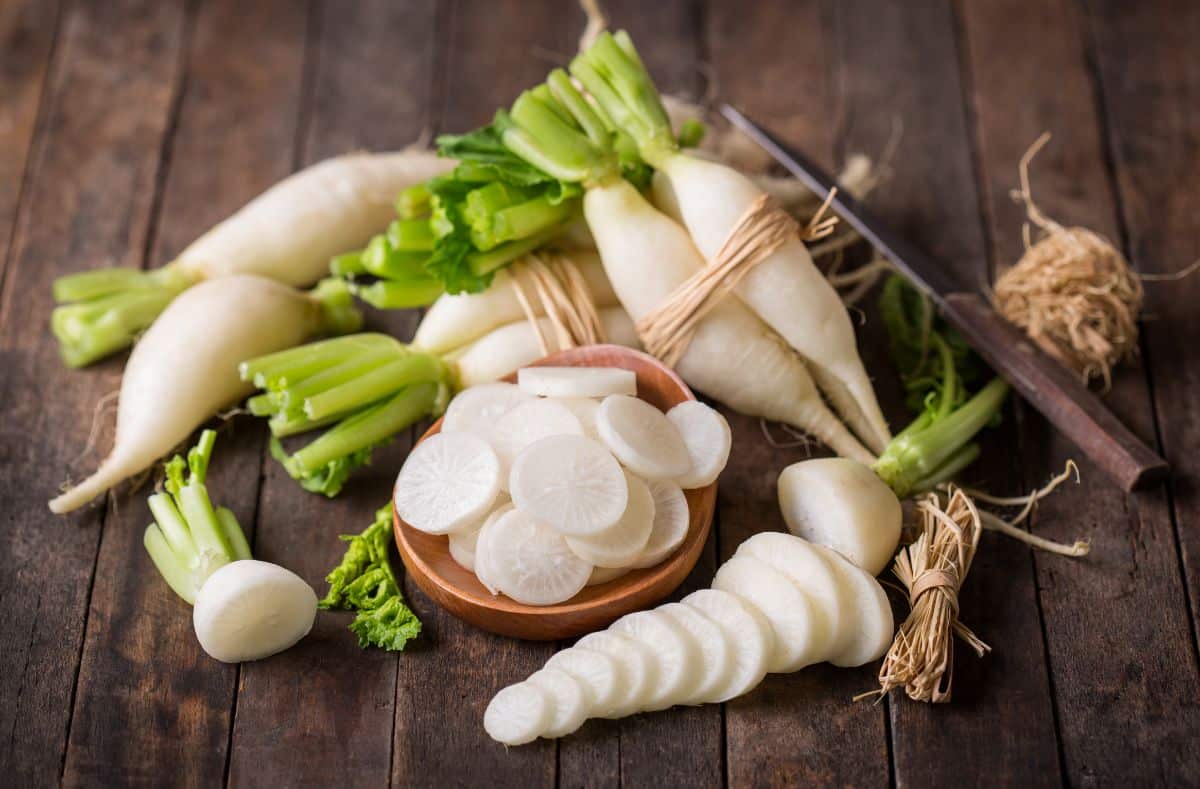
| Radish variety: | Tokinashi |
| Planting season: | Spring through late summer |
| Days to maturity: | 55 days |
| Skin color: | White |
| Interior color: | White |
‘Tokinashi’ radishes are classified as “all-season” vegetables because they’re slow to bolt in heat, but they can handle cold weather like champs too. A variety of daikon radishes, ‘Tokinashi’ is a traditional vegetable in Japan that can be used in many different dishes. The white, crisp roots have a strong pungency that may not be for everyone, but if you crave powerful flavors, ‘Tokinashi’ is definitely a radish to try.
‘Tokinashi’ is usually planted in spring or in mid-summer for an autumn harvest. Roots can stretch up to 16” long, so they do need deep beds or pots to grow properly. These radishes are ready to harvest in about 50 to 60 days, and they can be used sliced or grated in soups, salads, noodle dishes, and more!
15. Pusa Jamuni

| Radish variety: | Pusa Jamuni |
| Planting season: | Late summer |
| Days to maturity: | 55 days |
| Skin color: | Pinkish-purple |
| Interior color: | Pinkish-purple |
Spice lovers need to try out the colorful ‘Pusa Jamuni’ radish. This heirloom radish hails from India, and it’s another favorite at farmer’s markets thanks to its bright, pinkish-purple color that saturates its skin and interior flesh. These radishes look particularly stunning when thinly sliced, but they also work well in pickles and roast dishes too.
While ‘Pusa Jamuni’ radishes are mostly known for their rich coloration, these radishes are also packed with antioxidants, and they’re super nutritious to boot! Just keep in mind these radishes don’t handle heat well, so they should only be mid-summer and fall for a late-season harvest. When stored in a cool and humid environment, ‘Pusa Jamuni’ radishes will last for many weeks, providing you with tasty roots long into the winter months.
16. Red Rat’s Tail

| Radish variety: | Red Rat’s Tail |
| Planting season: | Spring through fall |
| Days to maturity: | 45 days |
| Skin color: | Purple pods |
| Interior color: | Purple pods |
Most radishes are cultivated for their crunchy roots, although growers also indulge in their edible greens. But, if you love exploring new foods and cuisines, ‘Red Rat’s Tail’ radishes offer a totally unique eating experience. After all, these radishes are grown for their tender and spicy seed pods, not their roots at all!
‘Red Rat’s Tail’ radish pods should be picked when they’re still young and measure about 5 to 6” in length. The pods themselves are a deep, purplish color, and they have a spicy flavor too. While these radishes make irresistible additions to pickles and noodle dishes, you can also enjoy ‘Red Rat’s Tail’ radishes fresh!
17. Saitaro

| Radish variety: | Saitaro |
| Planting season: | Spring and late summer |
| Days to maturity: | 69 days |
| Skin color: | Green and white |
| Interior color: | White |
‘Saitaro’ is a tapering daikon variety with tender, white roots that grow up to 12” long. This plant is a slow grower, but it will reward you with its easygoing nature and perfectly textured roots. Deliciously cooked, ‘Saitaro’ can also be eaten raw, but raw roots have a bit more of a spicy kick!
While ‘Saitaro’ can handle cool weather, it is also slow to bolt in heat, and it’s resistant to yellow wilt as well. Mature ‘Saitaro’ radishes grow very uniformly, and their long roots form blunt ends that look nice when gathered in bunches. As they grow, ‘Saitaro’ radishes produce a vigorous crown of leaves that shelter the plant’s roots and keep their shoulders from deepening into a dark green color.
18. Korean Fall Storage
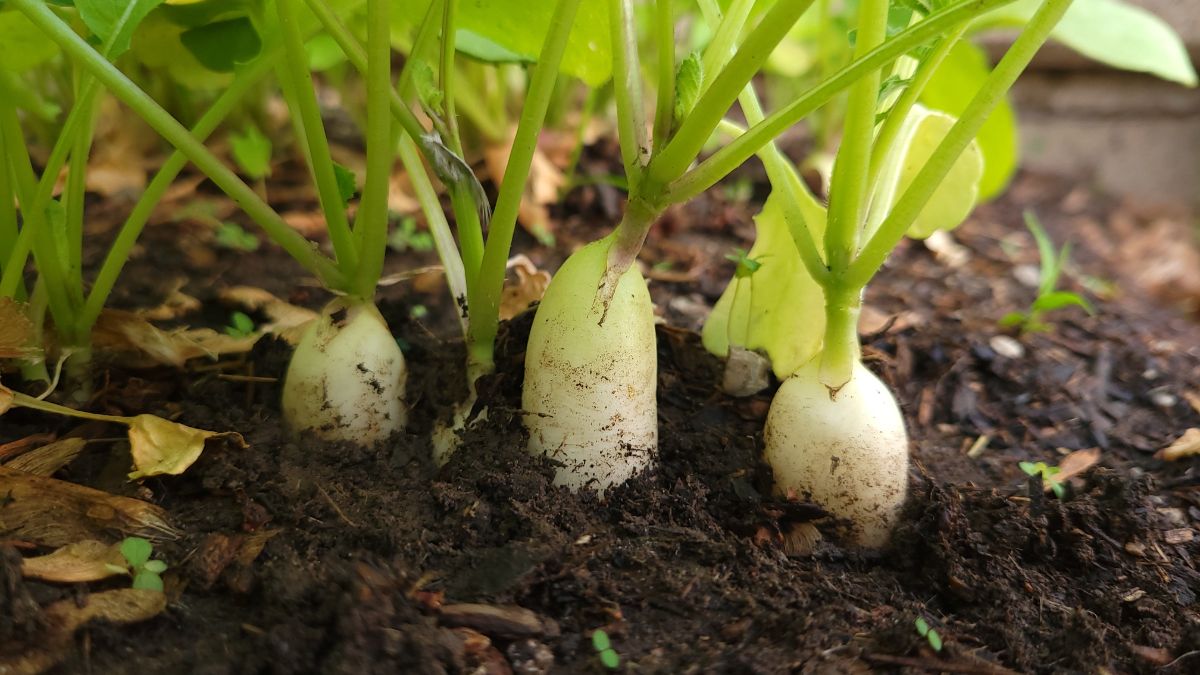
| Radish variety: | Korean Fall Storage |
| Planting season: | Late summer |
| Days to maturity: | 65 days |
| Skin color: | Green and white |
| Interior color: | White |
With a name like ‘Fall Storage,’ you know this radish is going to do well in root cellars, but ‘Korean Fall Storage’ radishes are also ideal for making tasty treats like homemade kimchi. These thick, white, and green radishes mature in about 65 days, and they thrive in cooler weather. Plant ‘Korean Fall Storage’ radishes towards the end of summer and reap the rewards with a large harvest of roots for pickling, roasting, and fresh eating.
In root cellars, ‘Korean Fall Storage’ radishes can easily last for about 4 months without their flavor diminishing one bit. What’s more, these radishes also have a good deal of disease resistance and can even withstand pathogens like the Turnip Mosaic Virus. Like other radishes, ‘Korean Fall Storage’ radishes are great companion plants for a wide variety of other vegetables, and they can be easily slipped in around the roots of taller growing plants.
19. Shunkyo

| Radish variety: | Shunkyo |
| Planting season: | Spring and fall |
| Days to maturity: | 35 days |
| Skin color: | Red |
| Interior color: | White |
An heirloom radish variety from China, ‘Shunkyo’ radishes have bright red skin and a tapering form that makes them look a bit like carrots. These radishes can pack a punch, though, and they have a pretty serious heat level that can spice up any dish they’re added to. Fast to mature, ‘Shunkyo’ radishes are ready to pull in about 30 to 40 days, although they’re best for growing in cool weather.
‘Shunkyo’ radish seeds are rarely sold in stores, but you should be able to locate them online if you want to give them a try. Like many other radishes, ‘Shunkyo’ works well in salads and homemade pickles, but it’s also often used in stir-fries. To ensure your roots develop well, amend your soil with a bit of compost before planting and mix it into the top 6 to 10” of your garden to loosen up the earth and make sure the compost nutrients are well incorporated.
20. China Rose

| Radish variety: | China Rose |
| Planting season: | Late summer to fall |
| Days to maturity: | 65 days |
| Skin color: | Pinkish-red |
| Interior color: | White |
Another stunning radish variety from China, ‘China Rose’ has a perfect contrast of colors with brilliant, pinkish-red skin and a bright white interior. A top pick for autumn gardens, ‘China Rose’ matures in about 60 days, and it’s mostly cultivated in fall and winter. These radishes grow to about 8” long, and their flashy, tapering forms will draw the eye at farmer’s markets.
‘China Rose’ radishes are flavorful and juicy with a nice crunch and a bit of spice. Cooked or fresh, these radishes are mouth-watering, and they also have good storage potential. Radish leaves are sometimes targeted by flea beetles, so if you want to enjoy their greens, you may want to sow strong-smelling herbs like catnip or sage near your radishes to keep pests at bay.
Summary

Thanks to the careful breeding practices of gardeners and seed keepers around the world, there’s a vast amount of diversity in the radish family today. While we love classic red and white radishes, if you’ve ever struggled to grow radishes in the heat, try out heat-tolerant summer radishes like ‘Zlata’ or ‘White Icicle.’ Growing bulky, storage radishes, like ‘Korean Fall Storage’ and ‘Watermelon,’ can even extend your growing season into late fall and winter, allowing you to harvest radishes almost year round!
With all of these colorful radishes to choose from, you may want to plant more radishes this year than ever before! However, if find yourself with more radishes than you know what to do with, this guide on how to use too many radishes can help.

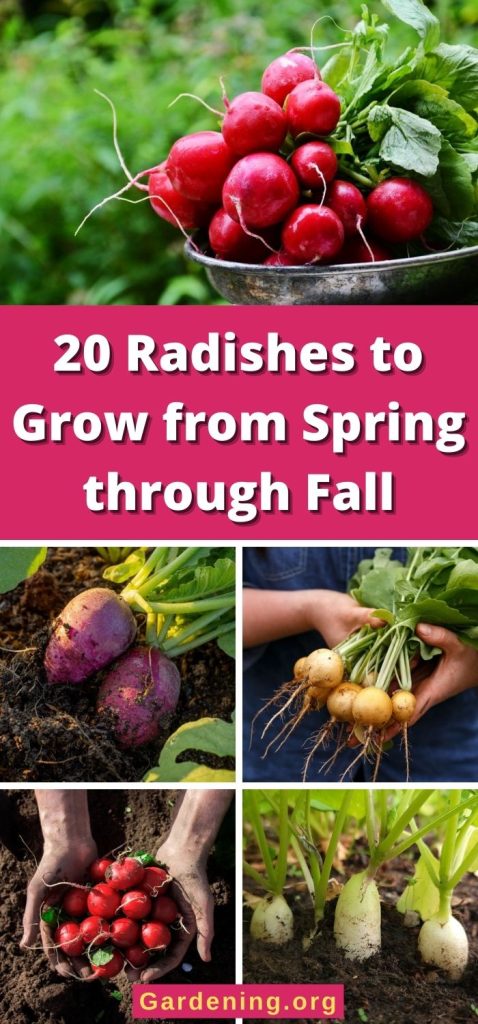
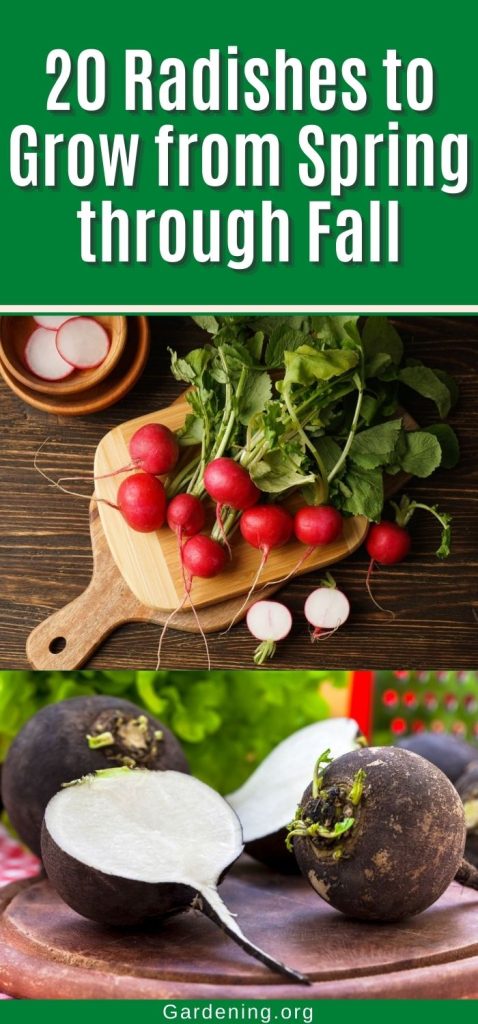
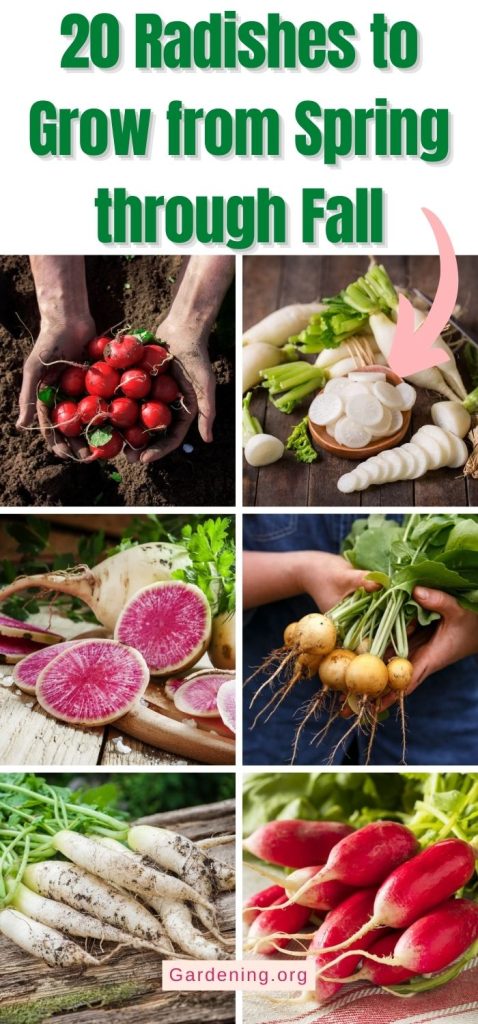

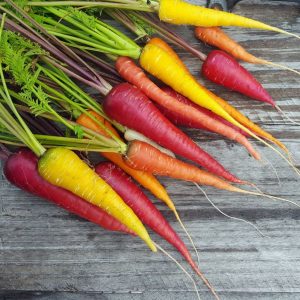
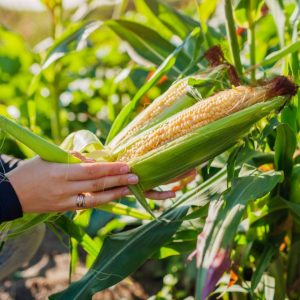
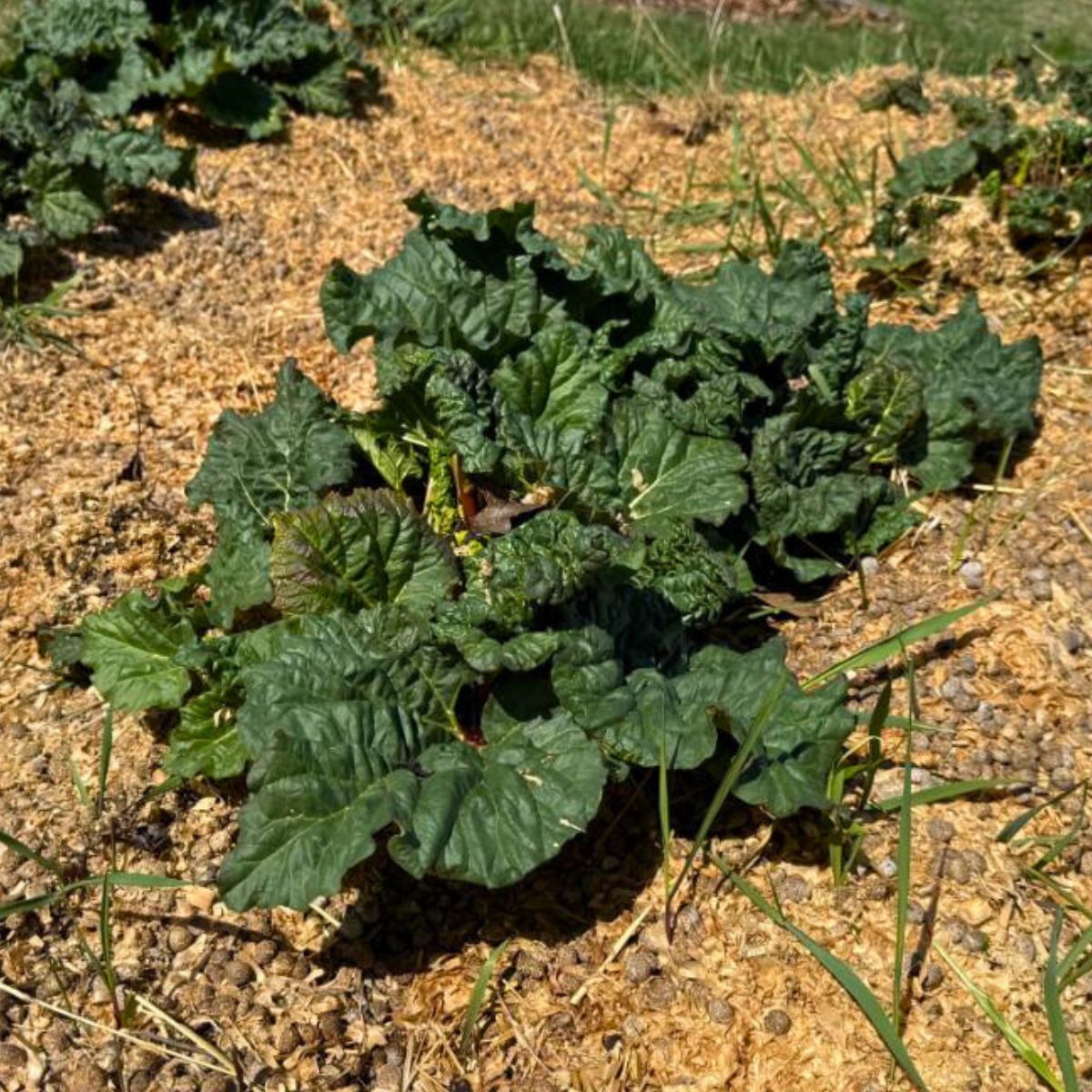
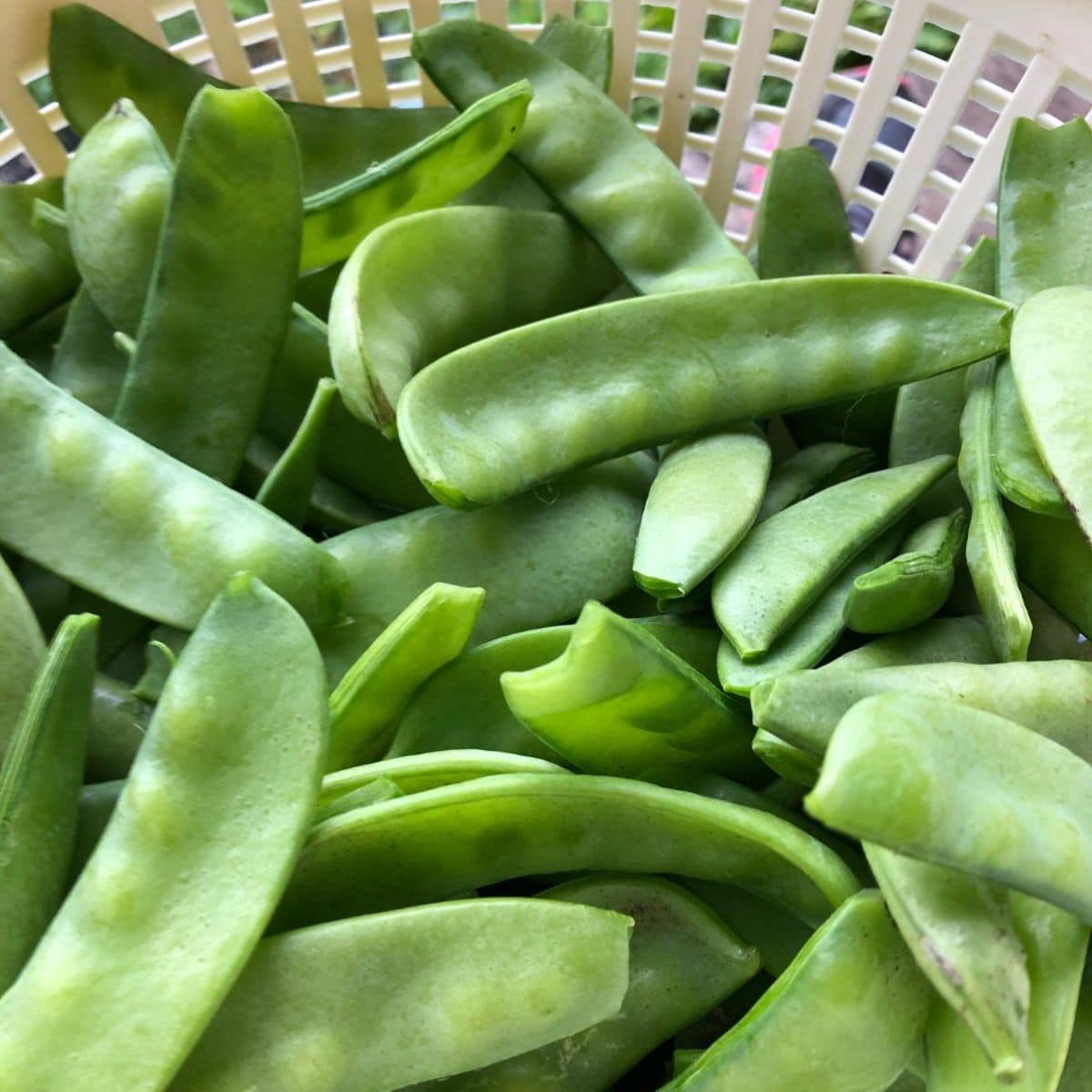
Leave a Reply